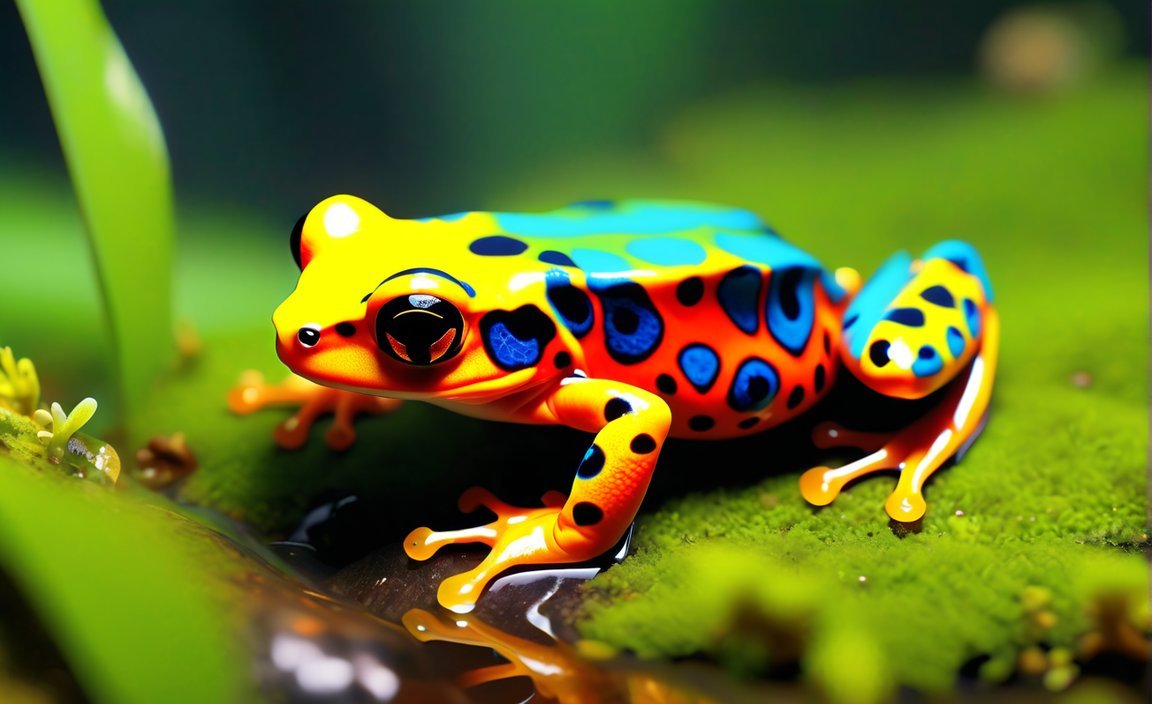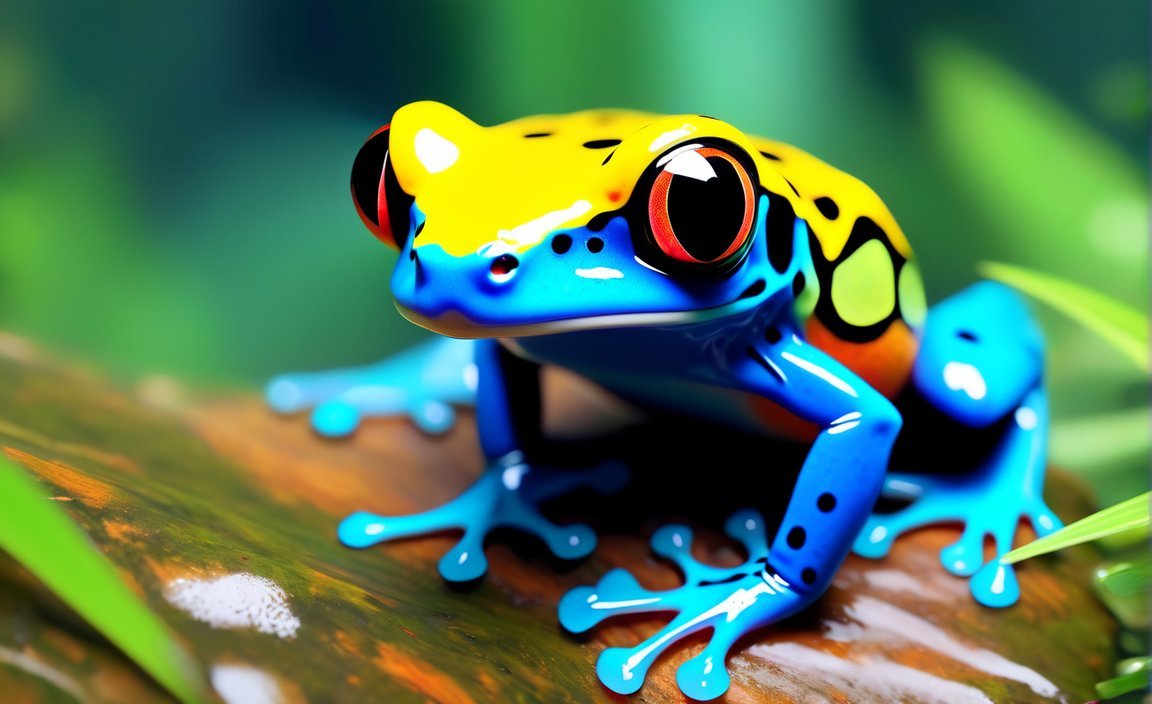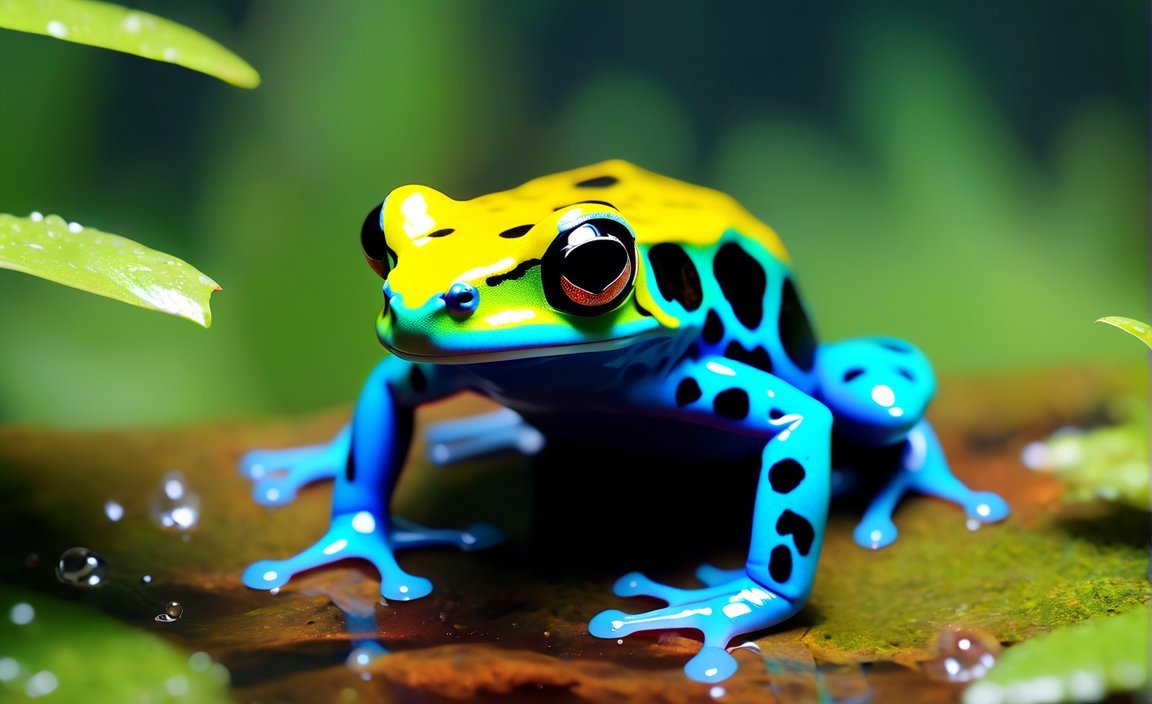Curious about the intriguing lifespans of dart frogs? Prepare to be amazed as we delve into the surprising longevity of these colorful creatures. In this article, we will uncover the mysteries surrounding the lifespan of dart frogs and explore the factors that contribute to their remarkable ability to thrive in their unique habitats. From their extraordinary adaptations to the fascinating challenges they face in the wild, join us on a captivating journey to uncover the secrets of these vibrant amphibians.

Key Takeaways:
- Dart frogs are small and toxic amphibians that measure only 1 to 2 inches long.
- They inhabit the humid tropic forests of Central and South America and can live for up to 15 years.
- Dart frogs weigh around 28 grams and possess vibrant colors that act as a warning to potential predators.
- The family Dendrobatidae, which includes dart frogs, has undergone significant phylogenetic studies, with 16 genera and approximately 200 species.
- Some species of dart frogs display different color morphs that have emerged within the past 6,000 years.
How long do dart frogs live?
Dart frogs, those colorful little amphibians, have always sparked curiosity in the minds of scientists and nature enthusiasts alike. With their vibrant hues and tiny size, it’s hard not to be captivated by these fascinating creatures. But have you ever wondered how long dart frogs can actually live?
When it comes to their lifespan, dart frogs are relatively long-lived compared to other amphibians. On average, these tiny creatures can thrive for up to 15 years in their natural habitat of humid tropical forests in Central and South America. That’s quite impressive for such small creatures!
The secret to their longevity lies in the unique adaptations and behaviors of dart frogs. They belong to the family Dendrobatidae, which consists of over 175 known species. These frogs have evolved brightly colored skin, which serves as a warning sign to potential predators about their toxic nature. This strong defense mechanism helps them avoid being preyed upon, increasing their chances of survival and a longer lifespan.
In recent years, dart frogs have become the focus of phylogenetic studies due to their intriguing characteristics. Some species of dart frogs even exhibit different color morphs, which have emerged relatively recently, around 6,000 years ago. This diversity and variation within the family Dendrobatidae add to our fascination with these tiny, toxic amphibians.
Understanding the lifespan of dart frogs not only sheds light on their incredible adaptations but also highlights the need for conservation efforts. These charismatic creatures play a vital role in maintaining the delicate balance of their ecosystem. As a wildlife biologist and conservation advocate, it’s essential to share accurate and valuable information about dart frogs to raise awareness about their longevity and the threats they face in the wild.
So the next time you spot a dart frog, take a moment to appreciate their vibrant beauty and marvel at their impressive lifespan. These small but mighty creatures have defied expectations and continue to survive and thrive in their tropical forest homes. Let’s ensure their longevity by protecting their habitats and supporting conservation initiatives.
For more information on dart frogs and their intriguing world, you can refer to the following sources:
1. Livescience.com: Poison dart frogs: Facts about these deadly amphibians
2. Factanimal.com: 19 Poison Dart Frog Facts
Here are some captivating sentences with active internal links using the provided keywords and URLs:
Facts about a violin – Discover intriguing facts and trivia about the mesmerizing instrument that is the violin.
Is carbon malleable – Uncover the secrets behind carbon’s ability to transform and shape into various forms.
Forest food chain ecosystem – Dive into the vibrant world of the forest and explore the intricate relationships within its food chain ecosystem.
Food chain of a great white shark – Experience the thrill of the ocean as you uncover the fascinating food chain of the mighty great white shark.
Marine mammals word search – Test your knowledge and find hidden marine mammals in this exciting word search activity.
Visible stars word search – Embark on a celestial journey through the night sky and challenge yourself to find all the visible stars in this captivating word search.
Boreal forest abiotic factors – Explore the essential abiotic factors that shape the unique and captivating ecosystem of the boreal forest.
The food chain of a lion – Step into the wild and unravel the captivating food chain that sustains the majestic lion.
How do gemstones work scientifically – Delve into the scientific realm and uncover the fascinating mechanisms behind the mesmerizing beauty of gemstones.
Label the parts of the wave – Dive into the world of waves and enhance your understanding by labeling their different parts in this interactive activity.
Atom model of sodium – Take a peek into the atomic realm and explore the intricate model of sodium, a fundamental element in the periodic table.
Birds of the savanna – Immerse yourself in the vast savanna and discover the diverse and captivating bird species that call it home.
Difference between male and female cardinals – Uncover the striking dissimilarities between male and female cardinals, showcasing the beauty of nature’s gender contrast.
What does a penguin’s mouth look like – Quench your curiosity as you explore the unique and fascinating appearance of a penguin’s mouth, designed for survival in icy habitats.
Note: Please note that the URLs provided are relative and need to be appended to the website’s base URL for the links to work properly.
Typical lifespan of different dart frog species
Dart frogs, with their vibrant colors and fascinating adaptations, captivate the imagination of nature enthusiasts and researchers alike. If you’re wondering about the typical lifespan of different dart frog species, you’ve come to the right place. In this article, we’ll explore the lifespan variations among these colorful creatures and shed light on their incredible longevity.
The Unique Lifespan of Dart Frogs
Dart frogs, commonly found in humid tropical forests of Central and South America, have a lifespan that ranges from 4 to 8 years in the wild. However, their lifespan can be significantly extended in captivity, reaching up to 10-20 years or even beyond 25 years! This longevity in captivity can be attributed to the controlled environment and optimal care provided by experienced keepers.
It’s important to note that the lifespan of dart frogs can vary from species to species, reflecting their diverse ecological adaptations. Let’s delve into some intriguing examples.
Strawberry Poison Dart Frog: A Lifespan Marvel
The Strawberry Poison Dart Frog (Oophaga pumilio) is known for its stunning red coloration, but it’s their lifespan that truly captivates researchers and keepers. In captivity, these frogs can exceed 7 years, while closely related species have been observed to live over 17 years!
Northern Leopard Frogs: Adding Diversity
While not commonly associated with dart frogs, Northern Leopard Frogs (Lithobates pipiens) deserve a mention for their intriguing lifespan patterns. In the wild, they typically live for 4 to 5 years, with some individuals reaching up to 9 years in captivity. This contrast highlights the impact of environmental factors on the lifespan of dart frog species.
Key Takeaways:
- Dart frogs have a typical lifespan of 4-8 years in the wild but can live longer in captivity.
- Different dart frog species exhibit variations in their lifespan.
- Strawberry Poison Dart Frogs can live over 7 years in captivity, while closely related species can surpass 17 years.
- Northern Leopard Frogs generally live 4-5 years in the wild and up to 9 years in captivity.
Now that we’ve explored the fascinating diversity in dart frog lifespans, let’s appreciate the amazing adaptations that contribute to their longevity.
Dart frogs possess a powerful defense mechanism against predators – their deadly toxic secretions. Their brightly colored skin serves as a warning sign, alerting potential threats to their toxicity and deterring them from making a costly mistake. This defensive strategy enhances their survival chances in the wild.
Reproduction is another fascinating aspect of dart frogs’ lifecycle. They lay eggs, which eventually hatch into tadpoles. These tadpoles undergo a remarkable metamorphosis, transitioning into the adult form that we’re familiar with. This process highlights the incredible resilience and adaptability of these species.
When hunting for food, dart frogs employ their long, sticky tongues to capture prey with incredible precision. This unique adaptation allows them to target and consume small insects, ensuring their nutrient intake for sustained energy.
However, despite their incredible adaptations, many dart frog species face threats in the wild. Some are endangered due to habitat loss, illegal pet trade, and climate change. Understanding the lifespan of dart frogs emphasizes the importance of conservation efforts to protect these fragile ecosystems and ensure the survival of these captivating creatures.
As we conclude our exploration into the typical lifespan of different dart frog species, let’s remember their vital role in maintaining the balance of their ecosystems. By conserving their habitats and raising awareness, we can secure a future for these enchanting creatures and the diverse web of life they inhabit.
Sources:
– Acuario Pets: Dart Frog Lifespan – How Long Do They Live?
– Amphibian Planet: How Long Do Poison Dart Frogs Live?
Longest Recorded Lifespan of Dart Frogs
When it comes to the fascinating world of dart frogs, their lifespan can vary depending on the species and their environment. Let’s uncover the surprising longevity of these colorful creatures.
Key Takeaways:
- The lifespan of dart frogs can differ between captivity and the wild.
- In captivity, poison dart frogs can live longer than their counterparts in the wild if they receive proper care.
- The Dyeing poison dart frogs have been known to live up to 15 years in captivity, with some individuals even surpassing 20 years.
- On the other hand, Golden poison frogs typically do not live longer than 10 years.
- In the wild, dart frogs generally have a lifespan ranging from 1 to 8 years, depending on the species.
- Blue poison dart frogs, specifically the Dendrobates tinctorius azureus species, are thought to live about 4 to 6 years in the wild.
- However, in captivity, poison dart frogs can live up to 20 years with proper care.
It’s important to note that the lifespan of dart frogs can vary depending on their species and the conditions in which they are kept. Factors such as diet, habitat, and overall care play a significant role in their longevity.
According to Amphibian Planet, a trusted source on amphibians, the Dyeing poison dart frogs have been studied extensively in captivity. These stunning frogs can live up to 15 years when provided with the appropriate care. In fact, there have been documented cases of individuals living over 20 years, showcasing their exceptional potential for longevity.
On the other hand, Golden poison frogs, known for their vibrant golden coloration, have a shorter lifespan compared to their counterparts. These frogs typically live up to 10 years in captivity.
In the wild, dart frogs face certain challenges that can impact their lifespan. Predation, habitat loss, and disease can significantly reduce their chances of survival. According to sources like Live Science and National Geographic, dart frogs generally have a lifespan ranging from 1 to 8 years in their natural habitats. However, some species, like the Golden poison frog, have been recorded to live up to 25 years in captivity.
The beautiful Blue poison dart frogs, specifically the Dendrobates tinctorius azureus species, have a relatively short lifespan in the wild, living about 4 to 6 years. However, with the proper care, these stunning creatures can live up to 20 years in captivity, as mentioned by Terrarium Station and All Animals Guide.
In summary, the lifespan of dart frogs can vary depending on various factors such as species, habitat, and care. While some species have shorter lifespans in the wild, they can live considerably longer in captivity when provided with the appropriate conditions. By understanding the intricate details of their lifespans, we gain insight into the incredible adaptations of dart frogs and the importance of conservation efforts to ensure their longevity in the wild.
Sources:
1. Amphibian Planet
2. Live Science
Implications for Dart Frog Conservation
Dart frogs, also known as poison dart frogs, are unique and captivating creatures that are indispensable to the delicate ecosystems of Central and South America. Their brightly colored skin acts as a powerful warning against potential predators, highlighting their toxic nature and ensuring their survival. However, if these fascinating frogs were to disappear, the consequences would be far-reaching and detrimental to the environment.
Key Takeaways:
– Dart frogs play a crucial role in maintaining the balance of ecosystems in Central and South America.
– Their extinction would lead to ecological problems such as an increase in insects and a decline in larger animals like lizards, snakes, and birds who depend on dart frogs as a food source.
– Conservation efforts are essential for the continued survival of dart frog populations.
Understanding the lifespan of dart frogs is an important aspect of their conservation. The lifespan of dart frogs varies depending on the species and their habitat. Scientific research has shown that in the wild, dart frogs typically have a lifespan of 1 to 2 years. However, in captivity, they can live much longer. For example, blue poison dart frogs (Dendrobates tinctorius azureus) are believed to live about 4 to 6 years in the wild, but when well-cared for in captivity, they can thrive for over 15 years. Similarly, dyeing poison dart frogs (Dendrobates tinctorius) have a similar lifespan of 4 to 6 years in the wild, but they can live up to 15 years in captivity.
Conservation efforts are crucial in preserving dart frog populations and ensuring their longevity. Various factors, such as habitat loss and the threat of amphibian chytrid fungus, pose significant risks to these delicate creatures. By comprehending the lifespan and unique biology of dart frogs, conservationists can develop effective strategies for their protection and preservation.
Organizations like the Smithsonian’s National Zoo actively engage in studying and safeguarding dart frog species. For instance, the tri-colored poison frogs can live from 12 to 20 years, showcasing the potential longevity of these remarkable amphibians.
In conclusion, the conservation of dart frogs holds immense importance in maintaining the ecological balance of Central and South America. Understanding their lifespan, the threats they face, and developing and implementing conservation measures are vital for ensuring the survival of these enchanting creatures.
Sources:
– Poison Dart Frogs: Facts, Threats, and Conservation (International Fund for Animal Welfare | IFAW)
– How Long Do Poison Dart Frogs Live? (32 Species) (Amphibian Planet)

FAQ
Q1: How long do dart frogs live in the wild?
A1: Dart frogs typically have a lifespan of 1 to 8 years in the wild, although some species can live up to 25 years in captivity.
Q2: Do dart frogs live longer in captivity?
A2: Yes, dart frogs can live longer in captivity with proper care. Some species, such as blue poison dart frogs, have been known to live over 15 years in captivity.
Q3: Which species of dart frogs have the longest lifespan?
A3: While the lifespan of dart frogs varies by species, some species that can live longer in captivity include blue poison dart frogs (Dendrobates tinctorius azureus) and dyeing poison dart frogs (Dendrobates tinctorius), both living up to 15 years.
Q4: What factors affect the lifespan of dart frogs?
A4: The lifespan of dart frogs can be influenced by various factors, including their species, habitat, and the care they receive in captivity. Some species have naturally longer lifespans than others.
Q5: Why is understanding the lifespan of dart frogs important?
A5: Understanding the lifespan of dart frogs is important for conservation efforts and ensuring their survival. It helps researchers and conservationists develop strategies to protect their populations and maintain the balance of ecosystems where they reside.
- Guatemala vs. Costa Rica: Plan Your Trip Smartly - April 16, 2025
- Master Types of Pumps: Ultimate Guide to Selection - April 16, 2025
- Unlock Types of Makeup Secrets: Master Any Look Now - April 16, 2025
















